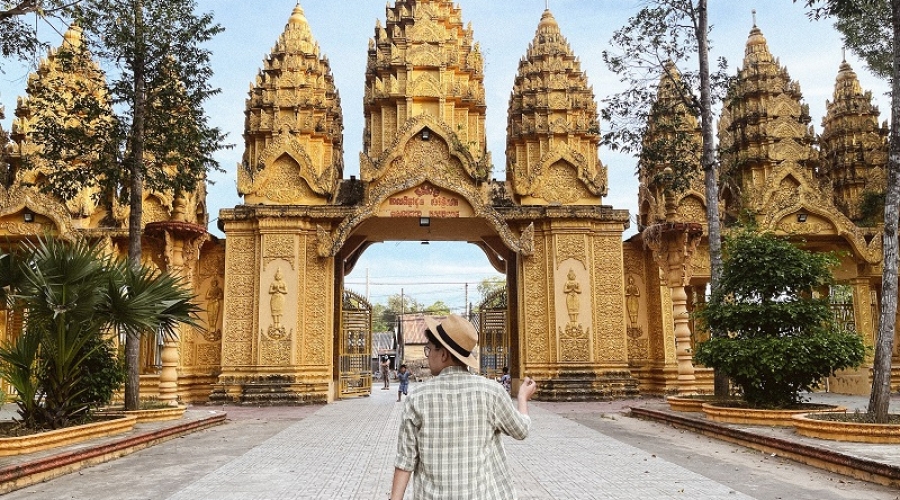
Sarnath: Where Buddha Delivered His First Sermon
Posted on April 2, 2024
Introduction
Sarnath, located near Varanasi in Uttar Pradesh, India, is one of the four most important Buddhist pilgrimage sites. It is here that Siddhartha Gautama, the Buddha, delivered his first sermon after attaining enlightenment. This significant event, known as the Dhammacakkappavattana Sutta or the “Setting in Motion of the Wheel of Dharma,” marked the beginning of the Buddha’s teaching career. In this blog, we will delve into the historical and spiritual significance of Sarnath, exploring its key landmarks and its enduring legacy in the Buddhist tradition.
The Historical Significance of Sarnath
The First Sermon
Sarnath’s most notable historical event is the Buddha’s first sermon, which he delivered to his five former companions, the Pancavaggiya monks. In this sermon, the Buddha introduced the core principles of his teachings, including the Four Noble Truths and the Noble Eightfold Path, laying the foundation for the spread of Buddhism.
Archaeological Discoveries
Sarnath has been the site of extensive archaeological excavations, revealing numerous ancient structures, artifacts, and inscriptions. These findings, which include stupas, monasteries, and statues, provide valuable insights into the early development of Buddhism and the region’s historical significance.
Key Landmarks in Sarnath
Dhamek Stupa
The Dhamek Stupa is one of the most prominent structures in Sarnath. Built by Emperor Ashoka in 249 BCE and later enlarged, this massive stupa marks the spot where the Buddha delivered his first sermon. The stupa, with its intricate carvings and imposing presence, is a focal point for pilgrims and visitors.
Chaukhandi Stupa
The Chaukhandi Stupa commemorates the site where the Buddha met his first five disciples. Originally a terraced temple, it was later modified into an octagonal tower by Mughal Emperor Akbar in the 16th century. The stupa is a significant landmark representing the Buddha’s initial reunion with his followers.
Ashoka Pillar
Emperor Ashoka, a devout follower of Buddhism, erected the Ashoka Pillar in Sarnath. This sandstone pillar, inscribed with edicts promoting Buddhist values, once featured a four-lion capital, which now serves as the national emblem of India. The pillar stands as a testament to Ashoka’s dedication to spreading the Buddha’s teachings.
Mulagandha Kuti Vihara
The Mulagandha Kuti Vihara is a modern Buddhist temple built by the Mahabodhi Society in the 1930s. It houses impressive murals depicting the life of the Buddha and serves as a place for meditation and worship. The temple’s serene atmosphere and beautiful surroundings make it a popular site for spiritual practice.
Sarnath Museum
The Sarnath Museum, established in 1910, is home to an extensive collection of artifacts excavated from the site. Highlights include the famous Lion Capital of Ashoka, Buddhist sculptures, and inscriptions. The museum offers valuable insights into the artistic and cultural heritage of ancient India and the development of Buddhism.
Spiritual Practices in Sarnath
Pilgrimage and Meditation
Sarnath attracts thousands of pilgrims and spiritual seekers annually. Visitors engage in meditation, chanting, and other spiritual practices at the various stupas, temples, and monasteries. These activities allow individuals to connect deeply with the sacred history of Sarnath and the teachings of the Buddha.
Festivals and Celebrations
Sarnath hosts several important Buddhist festivals, including Buddha Purnima, which celebrates the birth, enlightenment, and death of the Buddha. These events feature ceremonies, rituals, and teachings by prominent Buddhist monks, providing a unique opportunity to experience the local culture and religious fervor.
The Modern Relevance of Sarnath
A Global Spiritual Hub
Today, Sarnath serves as a global spiritual hub, attracting not only Buddhists but also people of various faiths interested in the teachings of the Buddha. The site’s development projects aim to preserve and promote its historical and spiritual heritage while providing modern amenities for visitors.
Educational and Cultural Center
Sarnath is also an educational and cultural center, with institutions like the Central Institute of Higher Tibetan Studies offering courses and research opportunities in Buddhist studies. These initiatives contribute to a deeper understanding of Buddhism and its historical context, attracting scholars and students from around the world.
Conclusion
Sarnath, where the Buddha delivered his first sermon, is a site of immense historical, spiritual, and cultural significance. Its ancient landmarks, tranquil environment, and rich heritage make it a must-visit destination for anyone interested in Buddhism. As a place of pilgrimage, meditation, and learning, Sarnath continues to inspire and guide individuals on their spiritual paths. Whether you are a devout Buddhist, a spiritual seeker, or a history enthusiast, a visit to Sarnath promises a profound and transformative experience. It is a journey to the very origins of Buddhism, where the Wheel of Dharma was first set in motion, and where the Buddha’s teachings continue to resonate across the world.
